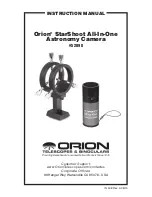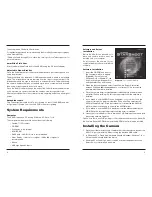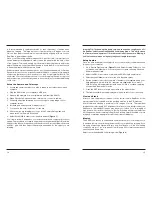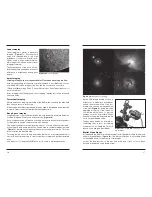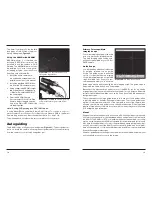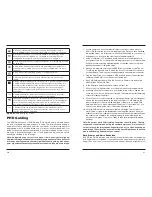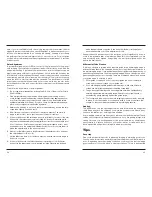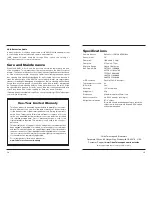
24
25
time of your mount. Additionally the varying seeing conditions makes the star
appear to jump around rapidly and cause the guider to make unnecessary cor-
rections, sometimes referred to as “chasing the seeing”. If seeing is poor, keep
the guiding correction intervals/exposures to 1 second or more. For most guide
scopes, we recommend setting the autoguide exposures between 1-4 seconds
for best results.
Polar Alignment
A good polar alignment of your EQ mount is of critical importance for long-expo-
sure imaging. Inaccurate polar alignment leads to field rotation, even with the
autoguider tracking. If your equatorial mount uses a polar axis finder scope, we
highly recommend utilizing it for polar alignment. If not, a technique known as the
“drift method” of polar alignment has been used for many years, and can achieve
an extremely accurate polar alignment. Unfortunately it is very time consuming,
since the drift of a star over time must be observed. The basic idea is to let the
telescope mount track while watching a star to see which way the star drifts.
Note the direction of the drift, and correct by moving the mount in the appropriate
direction.
To perform the drift method of polar alignment:
1. Do a rough polar alignment by pointing the R.A. axis of the mount at Polaris
(the NorthStar).
2. Find a bright star near the meridian (the imaginary line running north-to-
south through zenith) and near the celestial equator (zero degrees declina-
tion). Point the telescope at this star, and center it in an illuminated reticle
eyepiece (available from Orion). If you don’t have an illuminated reticle eye-
piece, use your highest-magnification eyepiece.
3. Determine which way is north and south in the eyepiece by moving the tele-
scope tube slightly north and south.
4. Now, let the mount’s motor drive run for about five minutes. The star will
begin to drift north or south. Ignore any east-to-west movement.
5. If the star drifts north, the telescope mount is pointing too far west. If the star
drifts south, the telescope mount is pointing too far east. Determine which
way the star drifted and make the appropriate correction to the azimuth posi-
tion of the mount. Rotate the entire mount (and tripod) slightly east or west
as needed or use the azimuth adjustment knobs (if your mount has them) to
make fine adjustments to the mount’s position.
6. Next, point the telescope at a bright star near the eastern horizon and near
the celestial equator (Dec. = 0).
7. Let the telescope track for at least five minutes, and the star should begin to
drift north or south.
8. If the star drifts south, the telescope mount is pointed too low. If the star
drifts north the telescope mount is pointed too high. Observe the drift and
make the appropriate correction to the mount’s altitude (or latitude); most
mounts have some sort of fine adjustment for this.
Repeat the entire procedure until the star does not drift significantly north or
south in the eyepiece after a few minutes. When this is accomplished, you are
very accurately polar aligned. Autoguiding on a well polar aligned mount will
deliver the best results.
Differential tube Flexure
A common obstacle in guiding with a separate guide scope and imaging scope is
differential tube flexure, the unwanted movement of a guide scope in relation to
the main imaging scope. If any part between the autoguider and imager moves or
flexes during the exposure, then the resulting image will have oblong stars which
gives the appearance of poor tracking. There are a few basic measures to ensure
your guide scope is securely in place:
1. If your guide scope has a focus lock, firmly tighten the focus lock thumb
screw after you have focused on your guide star.
2. If you are using adjustable guide scope tube rings, make sure all thumb
screws are firmly tightened against the guide scope tube.
3. The guide scope tube rings and mounting plate should be tightened very
securely against the main imaging scope. Check for any visual flexure or
movement by gently pressing against the guide scope.
4. The focuser and tube rings on the main imaging scope should also be firmly
in place. It is not uncommon for screws and bolts to come loose after a few
usages; so they should be checked before each imaging session.
Cabling
The SSAIO uses only two light-weight cables; a USB cable and the autoguider
cable. Keep an eye on the cables as you move the scope around. If there is any
stress on the cables, your tracking will be affected.
Some imaging cameras use heavy-duty cables with significant weight. These
cables can contribute to differential tube flexure. If you are getting images with
oblong stars and your tracking appears to be good otherwise, try attaching any
heavy cables to a secure location on your mount. It does not take much resis-
tance against the autoguider or imager to create poor tracking.
tips
Focusing
One of the hardest things to do in planetary imaging is achieving good focus.
You can make this process easier by simply watching the Live Video window to
focus. Depending upon the viewing conditions you may notice that the image
goes in and out of focus, this is due to viewing conditions. This is to be expected

